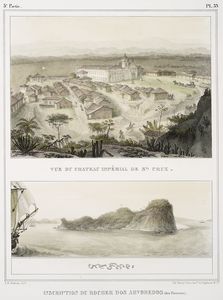A "Phoenician" rock inscription in the south of Brazil.
See Index on all my posts on Phoenicians in America.
We have already written about the Phoenician inscriptions on the Pedra da Gavea, at Rio de Janeiro. They are not the only ones in Brazil. Thera are more: according to an article published in 1829 [1], there are Phoenician inscriptions at the mouth of the Amargoso River, in Rio Grande do Norte (though the article does not describe them), and it also mentions those at Arboredo.
Rochedo dos Arvoredos
The article says the following:
Arboredo [sic], whose alleged Phoenician characters are deeply etched and measure no less than 40 feet [12.2 m] tall and can be seen from half a league away at sea.[1]
This crag, a rugged rocky island, is known, in Portuguese as the “Rochedo dos Arvoredos” (or "rock of the groves"). It is located at a short distance from the entrance to the Bay of Santa Catarina, in southern Brazil.
The island, now known as Ilha do Arvoredo(27° 17'S, 48° 21'W), is located about 12 km north of the large Island of Santa Catarina, where Florianopolis, the capital of the state of Santa Catarina is located.
It was depicted by the French artist Debret, [2] and his painting shows the characters. The image’s caption says that it “has an inscription in Phoenician characters very similar to others noted by Humboldt around America.”. (I should look up what Humboldt wrote about the Phoenicians in America!).
The following image [3] shows the “inscriptions”:
"Phoenician" inscriptions on the Rochedo dos Arvoredos, Santa Catarina, Brazil. Arrows show the inscriptions and a detail of them. Image by Debret [2][3].
Interestingly, Santa Catarina was during the period of conquest and discovery of South America, a key port, from which the Spaniards reached Asunción in Paraguay, by cutting across Santa Catarina (Brazil), Misiones (Argentina) and eastern Paraguay. It was shorter than going through the River Plate and Paraná and Paraguay rivers.
Sebastian Cabot and Sol&is (who discovered the River Plate) were shipwrecked there. It is likely that Phoenician sailors, moving south along the Brazilian coast would have found a safe port here. It also conforms to their chosen layout for settlements: a coastal island close to the shore with a well protected harbor. Santa Catarina Island is just like that.
Sources.
[1] Sociedad Económica de Amigos del País (Cuba), Cuba. Real Junta de Fomento de Agricultura y Comercio, (1829). Memorias. pp. 27
[2] Debret. Voyage pittoresque et historique au Brésil: ou Séjour d'un artiste français au Brésil, depuis 1816 jusqu'en 1831 inclusivement, epoque de l'avénement et de l'abdication de S. M. D. Pedro 1er, fondateur de l'Empire brésilien Re-edited by Livraria Martins, 1972>Vol 2. pp 228
[3] NYPL Digital Gallery:

Patagonian Monsters - Cryptozoology, Myths & legends in Patagonia2011 International Year of Forests Copyright 2009-2011 by Austin Whittall ©


















Check out latest on phoenician gene identified around the Med. Could this test be done in SA?
ReplyDeletewww.nytimes.com/2008/10/31/science/31genes.html
- - William
wgscribe@hotmail.com
Maybe yes, I have got some studies done in Brazil, but there may be some difficulty since Phoenicians visited Spain and what is now Southern Portugal... how can we separate direct Phoenician input in SA from the indirect genes from America's Spanish and Portuguese colonizers?
ReplyDeleteNevertheless I will look into it.
Thanks for the suggestion.
Austin